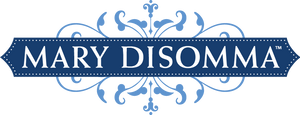Tips on How to Make a Simple (and Beautiful) Charcuterie Board
I love putting together charcuterie boards. They make impressive and entertaining centerpieces, and they couldn’t be easier to make. A charcuterie board makes a bountiful appetizer, perfect for serving before a meal. On the other hand, they are so bountiful that they can easily be served on their own.
Whether you’re in charge of the appetizer table on New Year’s Eve or just catching up with family and friends, the edible display of your festive charcuterie board will be the center of attention.

You can watch my video for tips and a quick how-to below or scroll down to read more!
What Makes for a Good Charcuterie Board?
The word “charcuterie” is French—it refers to a branch of cooking devoted to prepared meats such as bacon, ham, terrines, and patés. But with a last name like DiSomma, I’m obligated to go full-on Italian when I put mine together! If I didn’t include my favorite Italian meats and cheeses, I might be disowned. Don’t be shy about including your own favorites—add nuts, olives, crackers, spreads, and more for a really impressive tray. It’s all about the options. A good charcuterie board has plenty of choices built in! The more, the merrier, you know—and more is definitely more when I get going.
Don’t worry about replicating this—no two charcuterie boards are exactly alike. When I put one together, selections vary based on my mood and who I am having over. When you do it right, people can’t stop eating! I remember at one gathering, we ate so much charcuterie that we almost forgot the main course. We had to take a long break to digest before we could eat again.
What’s the best way to set up a charcuterie board?
You can use one big board, multiple smaller boards, or a mixture of both depending on the size of your crowd. The board itself doesn’t have to be fancy—it’s going to be loaded with food! You could even use a basic serving tray or a plain old cutting board.
Since our family makes our own giardiniera (you can try Billy’s hot giardiniera here), dilly beans (recipe and canning how-to here), and pickled beets, I make sure to include them on my board. After any homemade goodies, it’s just a mingling of cured meats, lots of cheese, a mix of fresh and dried fruit, nuts, olives, spreads, and pretty much anything else you can think of!
Start by arranging several small bowls on your board (or boards). Fill them generously with jam, preserves, mustards, nuts, or dips. Next, build around the bowl placement. Save a couple chunks of cheese to add height to your designs—like building blocks. Cheeses and meats can be sliced, cubed, or both. Make sure to intersperse some interesting crackers and breads so folks have a landing spot for all those toppings!
I personally like to save the dried and fresh fruits for last. They are fantastic for adding a pop of color and filling in the gaps between the other foods. Finally, don’t be afraid to sprinkle your board with some dried or fresh herbs. And viola! You’re ready to party!

Charcuterie Ingredients
The Cheese
Do your best to select cheeses that complement the meats on your platter. Including a spicy meat? Counter the spice with some creamy brie. Every bite should have its own unique flavor profile! I’m currently obsessed with:
- Aged Gouda
- Fontina
- Provolone
- Pecorino Romano
- Aged Cheddar
- Brie
- And finally, burrata—my new favorite!
The Meats
You might not be surprised to hear that I lean toward Italian meats. The best thing about these is that they’re loaded with flavor.
- Dry-cured salami
- Uncured salami
- Pepperoni
- Prosciutto
- Sopressata
- Capicola (Go all out and get the hot stuff!)
- Mortadella (If you can, get some that’s loaded with those beautiful green pistachios)
The Spreads
The superstar of a good charcuterie board is a delicious and interesting spread. I love including lots of different spreads in cute little bowls. The more special you can make them, the better! Try to get some unusual honey varieties (like mesquite or lavender), elderberry jam, savory chutneys, or sweet preserves like Montmorency cherry (which adds great holiday color, by the way!) Here are some of my best suggestions:
- Local organic honey—especially creamed or infused honeys
- Fruit preserves and jams
- Homemade pestos (don’t get stuck with basil blends—try an artichoke heart or beet pesto for starters!)
- Unique chutneys
- Whole-grain mustard
The Bread
Don’t forget to serve a dynamite bread with your charcuterie platter. This is the time to splurge and visit your local artisan bakery. Pick up a couple of different loaves (scratch-made is best), slice them up, and add them to your final charcuterie presentation. Yum.
Finishing touches for a next-level Charcuterie Board
You might not be surprised to hear that I lean toward Italian meats. The best thing about these is that they’re loaded with flavor.
- Dry-cured salami
- Uncured salami
- Pepperoni
- Prosciutto
- Sopressata
- Capicola (Go all out and get the hot stuff!)
- Mortadella (If you can, get some that’s loaded with those beautiful green pistachios)
A good variety of olives, roasted nuts, dried fruits, and Marcona almonds are great to nibble on and make fantastic finishing touches for a charcuterie board. Add fresh fruits (that won’t oxidize) like pomegranates, grapes, persimmons, and cranberries, and it won’t get much better than that! For holiday boards, add a few sprigs of fresh rosemary. It is an evergreen, after all!
Here are a few treats you may not have thought of yet:
- Roasted red peppers
- Sun-dried tomatoes
- Olives—lots of different kinds
- Giant caperberries (Think “really big caper with an elegant stem”)
- Marinated artichoke hearts
- Fresh fruit like grapes, blueberries, cherries, figs, and cranberries
- Dried fruits like mangoes, dates, and pineapple rings

